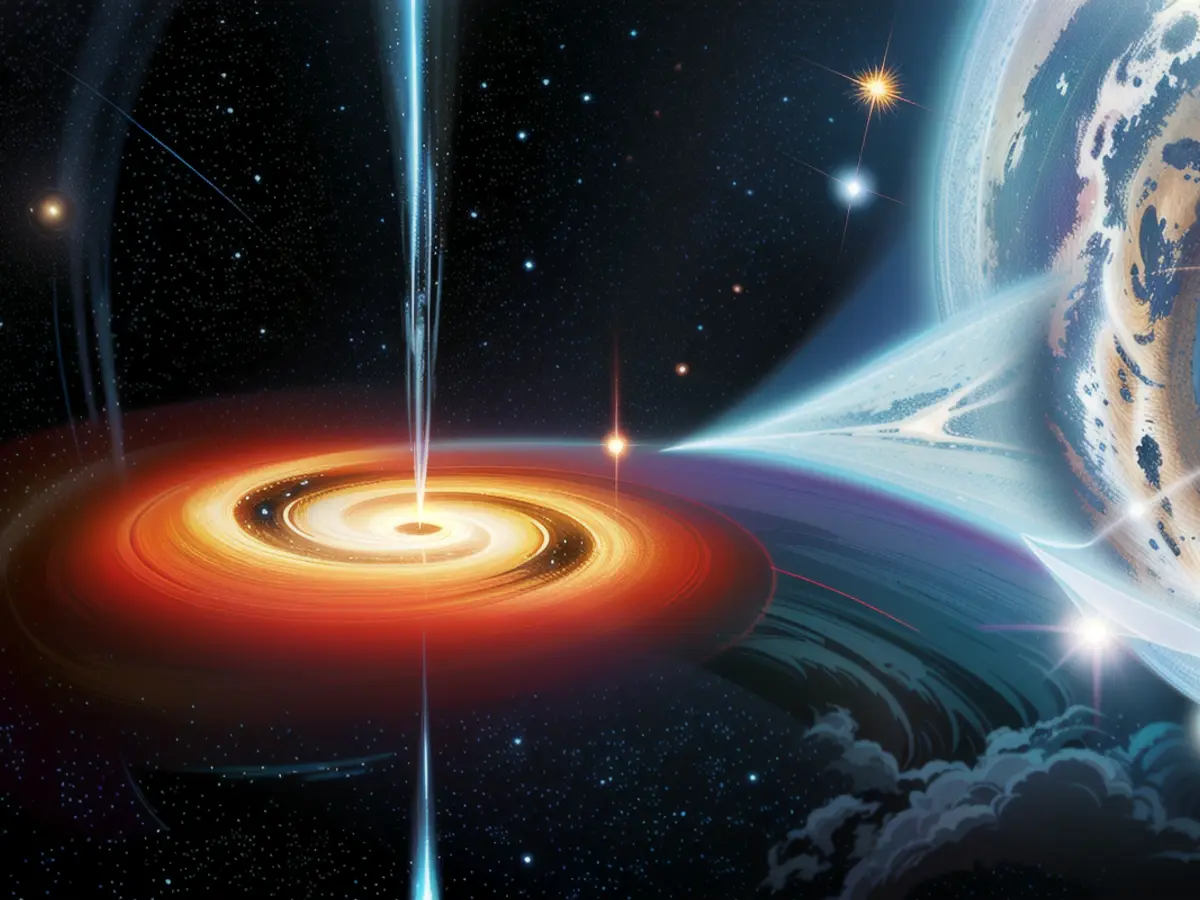Research confirms that black holes possess a 'plunge zone,' as proposed by Einstein.
A team of astronomers, armed with telescopes capable of sensing X-rays, has finally laid eyes on a long-ignored region of a black hole approximately 10,000 light-years away from Earth. This area, known as the "plunging region," had been overlooked because of the lack of data available. Andrew Mummery, a research scientist and the lead author of the study published in the journal Monthly Notices of the Royal Astronomical Society, said, "We've been ignoring this region, because we didn't have the data. But now that we do, we couldn't explain it any other way."
Black holes have previously aided in verifying Albert Einstein's seminal theory, known as general relativity. The first image of a black hole captured in 2019 bolstered the assumption that gravity is simply the fabric of space-time being bent by matter.
Einstein's other predictions have proven to be correct over time, including gravitational waves and the universal speed limit. Mummery, a fellow at the University of Oxford's Leverhulme-Peierls department, added, "He's a tough man to bet against at this point."
The search for this elusive plunging region was deliberate, Mummery disclosed. "We went out looking for this one specifically—that was always the plan. We've had arguments about whether we'd ever be able to find it for a long time. People said it would be impossible, so confirming it's there is really exciting."
'Like the brink of a waterfall'
The subject of this study involves a system called MAXI J1820 + 070, consisting of a star smaller than the sun and a black hole with an estimated mass of 7-8 solar masses. Paper authors employed the space-borne NuSTAR and NICER telescopes to study how the plasma, a hot gas, from the star is attracted to the black hole.
NuSTAR stands for the Nuclear Spectroscopic Telescope Array, while NICER (formally the Neutron star Interior Composition Explorer) is mounted on the International Space Station.
"Around these black holes, there are large discs of rotating material from nearby stars," Mummery said. "Most of it is stable, meaning it can flow smoothly, like a river. The plunging region, on the other hand, is like the edge of a waterfall—your support is gone, and you're crashing headfirst. The main sight is the river, but the tiniest portion of it is what we found."

Unlike the event horizon, situated closer to the center of the black hole and forbidding everything from escaping, including light and radiation, the plunging region permits light to escape. However, it's the powerful gravitational pull that dooms matter.
These findings could enhance astronomers' comprehension of the formation and development of black holes. Mummery said, "We can learn a lot about them by studying this region, because it's right at the edge, providing the most information."
While a picture of the black hole itself is absent—it's too small and distant—another group of Oxford researchers is attempting to create a movie of a black hole. This would be achieved by constructing a new observatory, the Africa Millimetre Telescope in Namibia. Mummery expects this facility to be operational within the next decade. Joining the international Event Horizon Telescope project responsible for the 2019 image of the black hole, it will enable astronomers to monitor and film giant black holes at the core of the Milky Way and beyond.
'A link to the past'
Christopher Reynolds, a professor of astronomy at the University of Maryland, asserts that this evidence of the plunging region will enable scientists to greatly refine models detailing how matter behaves around a black hole. "It can be used to measure the rotation rate of the black hole," he noted, adding that he was not involved in the research.
Dan Wilkins, a research scientist at Stanford University in California, considers this development an exciting prospect, as in 2018, one of the black holes within our galaxy sparked a bright explosion of light accompanied by an excessive output of high-energy X-rays. "We'd speculated at the time that this excess was from the hot matter in the 'plunging region,' but we didn't have a thorough theoretical explanation of what that emission would appear like around a black hole," said Wilkins, who also played no role in the recent study.
This study, he explained, performs that very calculation, using Einstein's theory of gravity to predict how X-rays released by material in the "plunging region" would be observable. This information was then compared to the data from the 2018 outburst. "This will be a significant area of discovery going forward over the next decade or so," Wilkins said, "as we anticipate even more powerful X-ray telescopes that will provide more detailed insights into the innermost areas just outside a black hole's event horizon."

Read also:
- This will change in December
- Dikes withstand water masses so far - Scholz holds out the prospect of help
- Fireworks and parties ring in 2024 - turn of the year overshadowed by conflicts
- Attacks on ships in the Red Sea: shipping companies avoid important trade route
This discovery of the plunging region in black holes could provide astronomers with a more profound understanding of black hole formation and development on a global scale. The findings may also contribute to the refinement of models explaining matter behavior around these cosmic phenomena.
Additionally, other researchers can now utilize this newfound knowledge to examine and predict X-ray emissions from materials in the plunging region, potentially leading to more detailed insights into the innermost regions of black holes beyond their event horizons.
Source: edition.cnn.com







